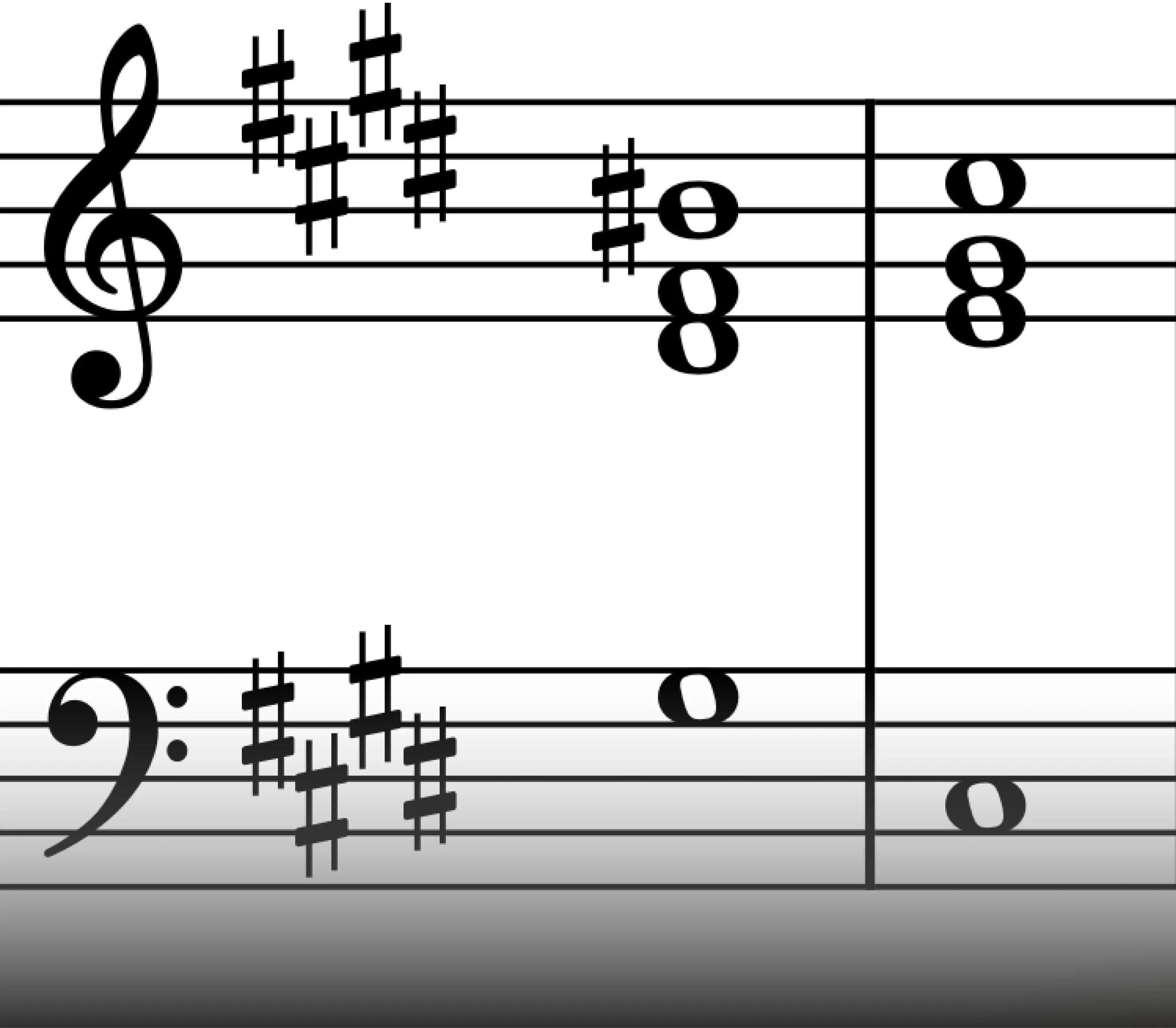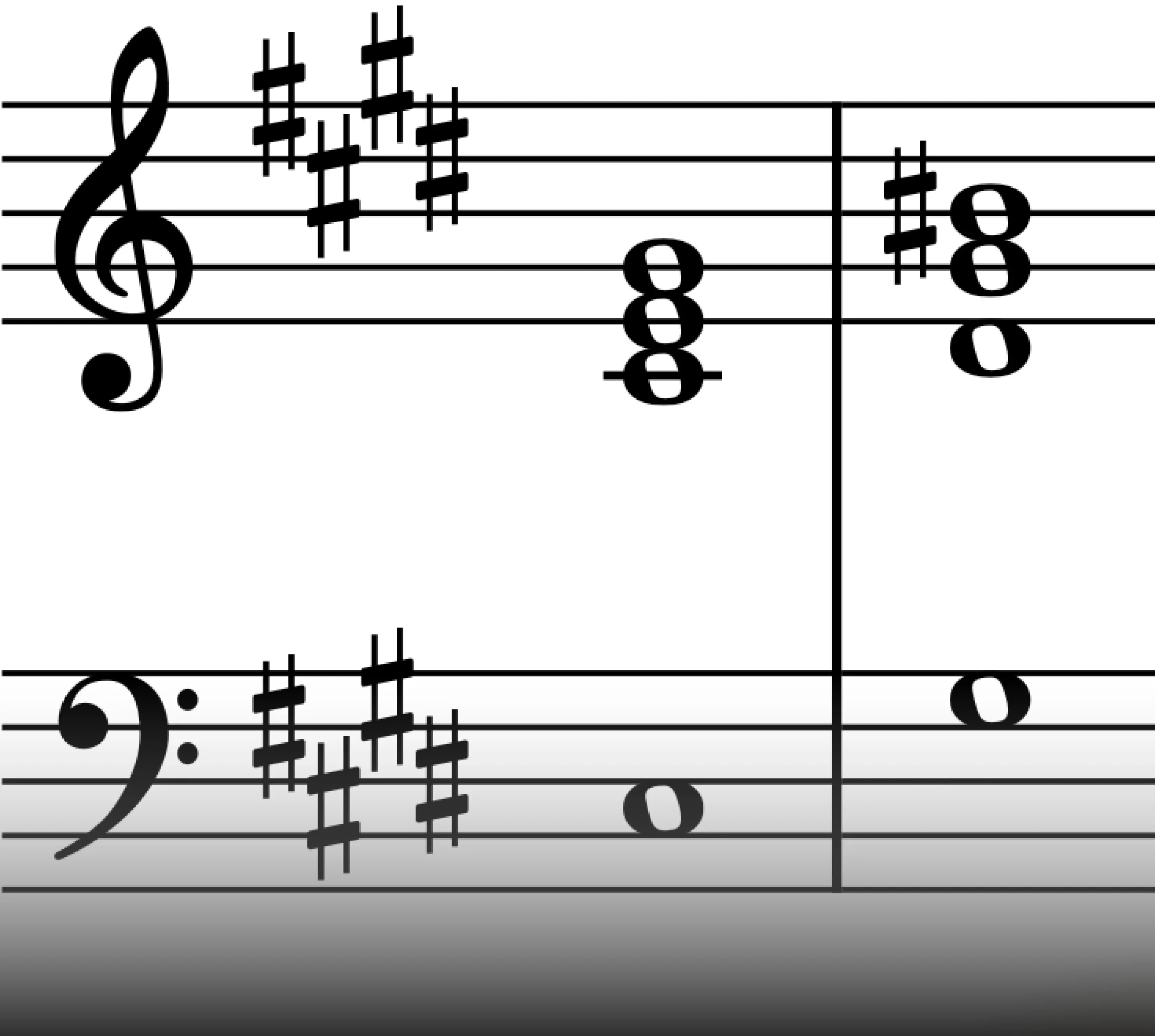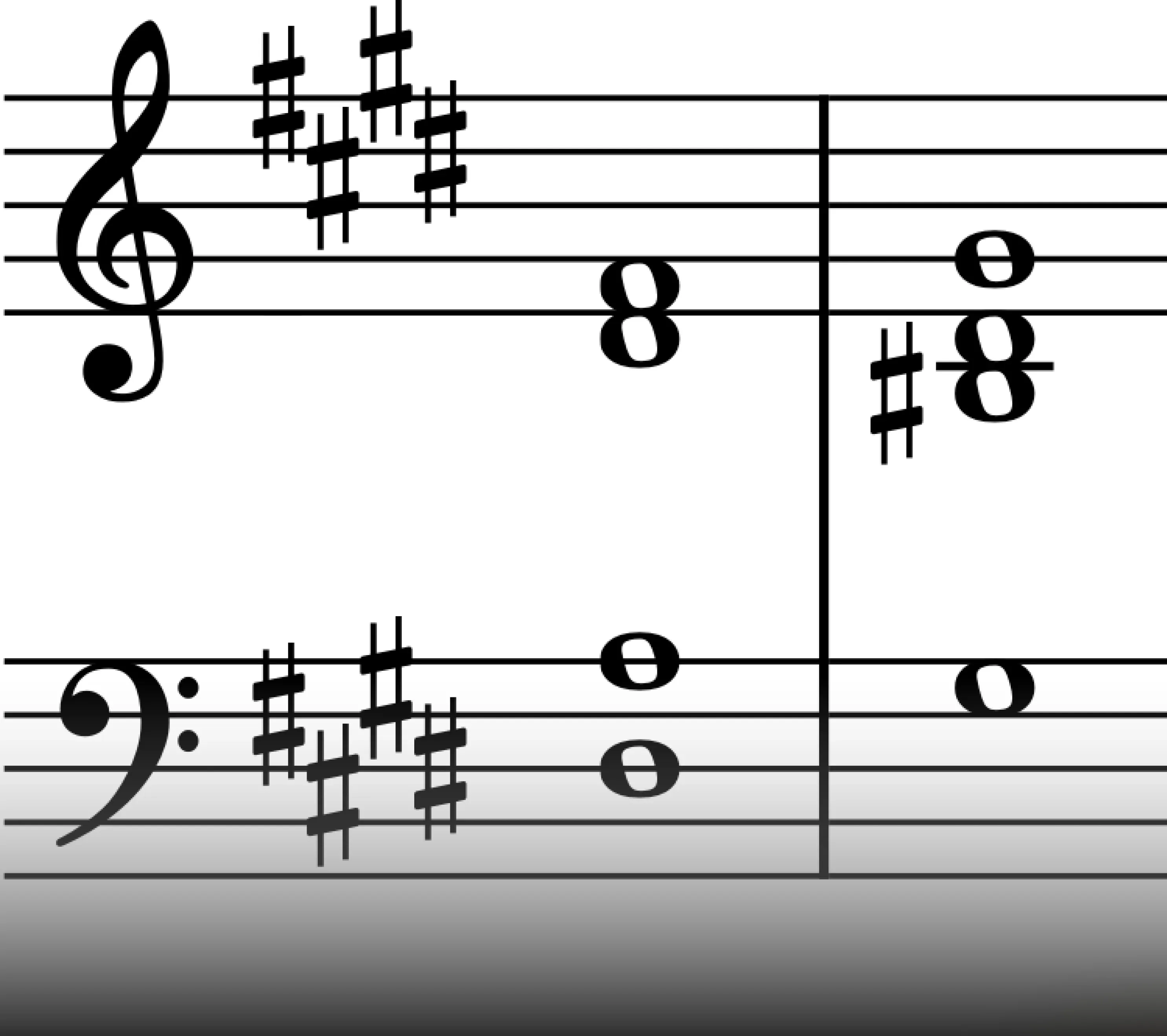
Learn the Chords in C# Minor: A Music Theory Resource
Master the C# Minor Key: Discover essential chords, useful progressions and techniques to elevate your music production and composing skills.
Introduction
A solid grasp of music theory is the best way to produce the music you hear in your head efficiently. Understanding the fundamental building blocks of harmony, such as diatonic and chromatic chords and their relationships, is crucial to writing interesting chord progressions.
In this article, we'll look at the C# minor key signature. You'll learn how to:
- Identify diatonic chords: Uncover the seven core chords that define C# minor and explore their function and harmonic qualities.
- Harness common progressions: Discover popular chord progressions that evoke powerful musical tension and resolution within the C# minor key.
- Use modal interchange: Explore techniques like parallel chords, secondary dominants, and the relative key to make your C# minor chord progressions more complex and interesting.
By the end of this guide, you'll have a deeper understanding of fundamental music theory, which will help you write better and more interesting music.
The Basics of C# minor
There are three main types of minor scales: natural, harmonic, and melodic. Generally, when we talk about a"minor scale"we mean a natural minor scale, unless otherwise specified.
The C# scale follows a specific pattern of whole and half steps, which is a defining characteristic of the Aeolian mode.


Every note in a scale has a specific position, called its scale degree. This position determines its harmonic function and the role it plays within the key's chord structure. Each chord's harmonic function is defined by its level of tension and characteristics relative to the tonic chord. Essentially, it measures a chord's stability or instability in the context of the tonic.
- C# - Tonic
- D# - Supertonic
- E - Mediant
- F# - Subdominant
- G# - Dominant
- A - Submediant
- B - Leading Tone
Roman numerals are used to indicate both a chord's harmonic function and its quality (major or minor). Uppercase Roman numerals represent major chords, while lowercase Roman numerals signify minor chords. The specific Roman numeral corresponds to the scale degree and harmonic function of the chord.

The diatonic notes of C# minor are those that naturally occur when you follow the Ionian whole and half-step pattern. The remaining notes are known as chromatic notes, which are powerful tools for adding harmonic richness, depth, and unpredictability to your chord progressions.
These chromatic notes can be used to create tension, modulate to different keys, or simply alter the quality of chords from major to minor, or vice versa. We'll explore this topic further in the section"Adding Complexity to C# minor Chords."
Raised Seventh and Major Dominant Chord
A common technique in minor key music is to raise the seventh scale degree by a half-step. This alteration, known as the harmonic minor scale, results in a major dominant chord instead of a minor one.
This major dominant chord contains a leading tone, which is only a half-step away from the tonic. This powerful leading tone exerts a stronger pull towards the tonic, leading to a more decisive and satisfying resolution compared to the natural minor scale.
When a diatonic note is modified, it's called an accidental. These alterations are indicated by sharp (♯) and flat (♭) symbols. To restore a note to its original diatonic pitch, a natural (♮) symbol is used.
Chords in C# minor
i: C# minor

The tonic note is the foundation of the scale and key signature, providing stability and a sense of resolution. Chord progressions that end on the tonic chord create a satisfying sense of resolution, like bringing the entire key signature home.
ii°: D# Diminished

The diminished supertonic chord functions as a leading-tone chord. It creates tension and strongly implies resolution to the tonic chord. Both the supertonic and dominant chords create a sense of instability and urge the progression toward the tonic for resolution.
III: E Major

Despite the tonic and mediant sharing two notes and having a similar tonality they offer contrasting major and minor qualities.
The shared notes make the mediant a suitable candidate for a tonic substitution. By strategically replacing the tonic with the mediant, especially in verses, you can heighten the impact of the tonic chord, particularly in climactic moments like choruses or powerful cadences.
It’s also a great way to add variety in your music to avoid resolving to the same chords over and over again.
iv: F# Minor

The iv chord, the subdominant, offers several possibilities and directions. Compared to the tonic, it offers a contrasting element that builds anticipation, needing resolution. Perhaps the most natural direction is another step to the dominant chord, where tension is further increased.
The subdominant chord also transitions seamlessly to the vi chord, creating a satisfying minor-major interval.
v/ V: G# Minor/ G# Major


The inherent dissonance of the dominant pulls it towards the tonic for a strong resolution. For an even stronger resolution, the dominant seventh chord is employed. The fifth scale degree is the only position where the dominant seventh chord appears naturally, making it a powerful diatonic chord.
VI: A Major

The submediant chord provides a contrasting color and a sense of temporary resolution. It's often used to create a sense of calm or introspection before returning to the tension of the dominant or tonic.
It can also be used to modulate to other keys, particularly the relative major (we’re returning to this concept later).
VII: B Major

Its major quality allows for a smooth transition to the tonic chord. Additionally, the subtonic chord can function as a pre-dominant chord, leading to the dominant and creating anticipation and tension. This makes it a valuable tool for adding color and depth to your harmonic palette.
Primary and Secondary Chords in C# minor
Diatonic chords in C# minor are divided into two categories: primary chords and secondary chords. The former provides the fundamental harmonic structure of the key, while secondary chords add depth and colors to the chord progression.
- The primary chords are I, IV, and V
- The secondary chords are ii, iii, vi, and vii°

Understanding Chord Relationships and Intervals
To truly grasp chord intervals, tonality, and quality, experiment with a variety of chord combinations. Begin with the tonic chord and explore the intervals of each diatonic chord. Additionally, experimenting with chord inversions will help you understand how they alter the sound and stability of each chord.
A strong foundation in scale patterns and intervals is essential for writing harmonious melodies and well-structured chord progressions, regardless of genre or style. Recognizing the pattern of half and whole steps in C# minor will facilitate smoother voice leading, minimizing large leaps between notes during chord transitions.
A great way to learn to recognize intervals is to associate them with familiar songs. Our article on Ear Training provides a list of songs that utilize each interval, both ascending and descending.
Cadences in C# minor chord progressions
A crucial element in creating dynamic music is the effective use of cadences. Cadences serve as musical punctuation marks, signaling the end of a phrase or section. By utilizing a variety of cadences, producers, and composers can broaden the spectrum of musical expression, ranging from powerful climaxes to subtle and ambiguous endings.
In the following section, we'll explore common cadences in C# minor.
Perfect Cadence
Dominant → Tonic (V - i)
G# → C#m

The V-I cadence, with its powerful resolution, is a well-known technique for concluding musical phrases or songs. Its clear and decisive ending has become synonymous with musical closure. An even more potent resolution is achieved when a dominant seventh chord resolves to the tonic.
G#7 → C#m (V7 - i)

There are two conditions that must be met for a perfect cadence to occur: both the dominant and tonic chords must be in root position (meaning the root of each chord is the lowest note), and the highest note of the tonic chord must also be the root of the chord. These are the conditions that guarantee the strongest resolution.
Plagal Cadence
Subdominant → Tonic (IV - i)
F#m → C#m

The plagal cadence, often referred to as the"Amen Cadence,"offers a gentler conclusion compared to the perfect cadence. This cadence has been frequently used in traditional hymns, often played to the final phrase"amen,"earning it the nickname"the amen cadence."
Half Cadence
Tonic, or Supertonic, or Subdominant → Dominant: (i / ii / iv → V)
C#m→ G#

D#° → G#

F#m→ G#

A half cadence ends a musical phrase on the dominant chord. Unlike perfect and plagal cadences, which offer a sense of definitive closure, the dominant chord is inherently unstable, leaving the phrase feeling unresolved.
The half cadence is a powerful tool for building anticipation. Ending a bridge or pre-chorus on the dominant chord sets the stage for an impactful tonic chord to initiate the subsequent section. This strategic use of the half cadence can significantly enhance the overall dynamic and emotional journey of your music.
Interrupted Cadence
Dominant to Submediant (V - vi)
G# → A

The interrupted cadence initially hints at a strong and definitive resolution. However, it takes an unexpected turn and instead concludes on the submediant chord. If the music intends to modulate to the relative minor key, this cadence can serve as a bridge between the two tonal centers.
Common Chord Progressions in C# minor
In this section we’ll look at some interesting chord progression in C€# minor by known artists. We'll highlight the strategic use of chords like the mediant and submediant as substitute tonic chords, and explore various cadences.
Remember, a cadence is more than just the final two chords of a progression. It's an intentional musical punctuation. A I-V-I sequence isn't a perfect cadence unless it completes the musical phrase.
Let's explore common chord progressions in C# minor.
I (C#m) - iv (F#m) - III (E) - v (G#m)
Amy McDonald's"This is the Life"uses a captivating chord progression that highlights the unexpected contrast between a major mediant and a minor dominant chord. The uplifting quality of the mediant heightens the minor quality of the subsequent dominant chord, creating a dynamic and memorable musical moment.
I (C#m) - III (F#) - VII (B) - iv (F#m)
This chord progression only features one primary chord, creating a sense of ambiguity and loop-friendly fluidity. A progression like this works really well for pop music that tends to have repetitive chord progressions.
Lady Gaga’s “Just Dance” uses this exact chord progression.
i (C#m) - VI (A) - III (E) - VII (B)
This chord progression stays within a familiar tonal center by playing the tonic, submediant, and mediant in a row. The subtonic doesn't provide much other than naturally leading back to the tonic.
We hear this progression in the verse of Linkin Park's anthem"Crawling". The same chords are used in the chorus, but instead of C# minor, they use the parallel chord C# major. We return to parallel chords later on.
By changing the order of the Submediant and the Mediant we get the progression i-III-VI-VII which Link Park uses in “Faint”. This is also the start to the chorus of Shakira’s Whenever Wherever which we’ll look at below.
i (C#m) - V (G#) - VI (A) - III (E) VII (B)
The opening i-V interval in Shakiras’s"Whenever Wherever"creates a strong harmonic pull, drawing the listener away from the tonic. The next submediant and mediant chords brings it back to the familiar tonality without properly resolving the progression. Finally, it ends on the VII chord which smoothly resolves the progression to the tonic.
i (C#m) - iv (F#) - VI (A) - VII (B)
Ed Sheeran’s hit “Shape of You” uses these four chords on repeat throughout the entirety of the song. What’s interesting is that the first two chords establish a minor quality and the next two chords are uplifting major chords. This clear contrast between minor and major keeps it interesting despite the repetitiveness.
i (C#m) - III (E) - V/VII (F#) VI (A)
Avicii's"Addicted to You"effectively utilizes a descending bassline and a secondary dominant chord to create a captivating chord progression. The downward motion of the bassline, combined with the tension and release provided by the secondary dominant, results in a great, dynamic and memorable chord progression.
Playing Chords Outside of the Key Signature
The Aeolian mode provides us with the diatonic notes of a natural minor scale. But that doesn't mean that the diatonic notes are the only ones we can use in a C# minor key signature. By incorporating chromatic notes, we can expand the harmonic palette, creating deeper and more interesting chord progressions.
Chromatic notes serve as building blocks for constructing diminished, augmented, and various major or minor chords. Additionally, modulating to the relative major key is a powerful technique for expanding a song's harmonic landscape. We'll delve into this next.
Relative Major: E Major
Every major key has a corresponding minor key, and vice versa. These key pairs share the same notes but differ in their tonal centers and chord functions.
The relative major:
In a minor scale, the relative major is found on the third scale degree, the mediant. In C# minor, that’s E major.
The relative minor:
The relative minor is found on the sixth scale degree, the submediant. In E Major, that’s C# minor.
Modulating Between Relative Keys
Modulating to E major opens up a new tonal world with seven distinct diatonic chord functions, all within the same key signature. For more information about E Major, check out the article "Learn the Chords in E Major".
The close relationship between E major and C# minor allows for exciting harmonic exploration. This subtle tonal shift can add depth and create distinct emotional tonalities for different sections of a song.
Modulating between relative keys is a common technique to prevent a song from becoming stagnant and keep it developing. For instance, transitioning from C# minor to its relative major, E major, can create a sense of uplift and energy. Conversely, moving to the parallel minor, C# minor can evoke a more melancholic and somber mood.
Adding Complexity to C# minor Chord Progressions
To add depth and intrigue to your music, consider temporarily shifting to a different key or altering the qualities of diatonic chords. These techniques can create dynamic movement within your music and compositions without disrupting the overall tonal foundation.
In the next section, we'll explore parallel chords and secondary dominants, two simple yet powerful tools for adding complexity to chord progressions.
Parallel Chords
Parallel chords are created by altering the quality of a chord through accidentals which offer unexpected harmonic twists. For example, lower the third of the mediant chord from G♯ to G in a chord progression creates a E minor chord, which has a distinct emotional impact compared to the major mediant.
For example, the interval between a minor tonic and a minor mediant, known as a chromatic mediant, has a distinctly dark and somber sound. You can learn more about chromatic mediants in our article on Dark Chord Progressions.
Occasionally, temporarily using C# major as the tonic is a great way to add unexpected tonal shifts in your music.
Remember to use parallel chords carefully. Overusing them can disrupt the natural harmonic flow of the music and diminish their impact. Use them strategically to highlight specific moments and elevate the overall tonal richness of your song.
Secondary Dominants
A secondary dominant is a dominant chord that is borrowed from a key other than the main key of the song. It's used to create a sense of harmonic tension and resolution, adding richness and complexity to a chord progression.
A common secondary dominant chord is built on the 5th scale degrees and is called the “dominant of the dominant!”. For example, by temporarily treating the primary dominant chord as a tonic, we can precede it with its own functional dominant chord. In this instance, our primary dominant is G# and its functional dominant is D#. This creates a V-I interval and can look like this:
I (C#m) - V/V (D#7) - V (G#7) - I (C#)

A basic grasp of music theory can instantly elevate your music production, composition, or songwriting. By understanding the relationships between chords and notes, you'll gain the power to craft more intentional and emotionally resonant music.
How Musiversal Can Help You Write the Best Music
When you work with Musiversal’s talented musicians, a solid understanding of music theory becomes invaluable. This knowledge empowers you to effectively communicate your musical vision, ensuring that your ideas are brought to life.
For instance, including a V/V in your chord chart signals the intent of a secondary dominant, guiding musicians to connect chords through specific voice-leading techniques.
If you're looking for assistance in writing compelling chord progressions or adding harmonic depth, our pre-production and songwriting experts are here to help.
With a Musiversal Unlimited subscription, you gain unlimited access to a network of over 80 professional musicians and award-winning engineers. Together, you can bring your musical dreams to reality.
Your Music, No Limits.
Join the Waitlist